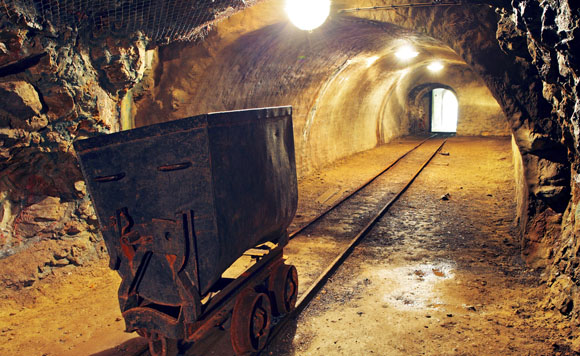The Gold Report: In the December 2014 edition of the Hallgarten & Co. Model Mining Portfolio, you outlined some reasons for investors to be cheerful. Please share some.
Chris Ecclestone: The first is the oil price. The mining space has been afflicted with capital and operating expenditure inflation for 10 years. One of the most sustained rises on the operating expenditure side has been energy costs; mining companies have been paying massively more for oil than they were 10 years ago. The 40–50% tumble in the oil price has reduced those input costs.
"Atna Resources Ltd.'s stock price has quite a lot more mileage in it."
Another factor is that many of the commodity currencies have retreated heftily. The Canadian and Australian dollars, the South African rand, even the Russian ruble, have retreated to levels that essentially provide a "double whammy." It definitely helps the producers in those currencies.
TGR: Are there other positives?
CE: I think there's going to be a merger and acquisition (M&A) surge this year. We've already seen a few transactions. The obvious ones are not happening, yet some surprises are happening. Anything that's out there could be subject to a takeover.
TGR: We've seen Osisko Gold Royalties Ltd. (OR:TSX) take over Virginia Mines Inc.; Tahoe Resources Inc. (TAHO:NYSE; THO:TSX) make a bid for Rio Alto Mining Ltd. (RIO:TSX; RIOM:NYSE; RIO:BVL); Goldcorp Inc. (G:TSX; GG:NYSE) buy Probe Mines Ltd. (PRB:TSX.V) and Coeur Mining Inc. (CDE:NYSE) take over Paramount Gold and Silver Corp. (PZG:NYSE.MKT; PZG:TSX). What are some takeaways from the deals we've seen so far?
CE: One is the marriage of partners that have not been the subject of speculation. Another is that companies are doing deals with stock in order to preserve cash. And no one is saying that these deals are at ritzy prices. Some management teams have learned not to overpay by offering prices that work for both parties. We certainly haven't seen any bidding wars.
TGR: In a recent edition of the Model Mining Portfolio you suggested a few companies that you thought could be targets as M&A gains pace this year. What do those targets look like?
CE: The portfolio is primarily looking for stories that might get taken over. I'm looking for targets where it makes sense to bolt two names together. Much of my list consisted of medium and large miners. There is speculation that Vale S.A. (VALE:NYSE) will spin out its base metals assets. BHP Billiton Ltd. (BHP:NYSE; BHPLF:OTCPK), too, is spinning out its non-core metals. Then there is a sort of school of private equity funds and mining wannabes, like Mick Davis' X2 Resources L.P. (privately held)—Mr. Davis built up Xstrata Plc before it was taken over by Glencore International Plc (GLEN:LSE)—that are swimming around stricken companies like Nyrstar (NYR:BSE), the big zinc miner and refiner, and Finland's Talvivaara Mining Co. Plc (TALV:LSE), which is essentially bankrupt.
A group that's cashed up, like the private equity funds or X2, could move on some of these distressed assets and bring them into situations where one plus one hopefully equals five, rather than just two. People want accretive deals.
TGR: Any specific names?
CE: Nyrstar is one of the prime assets out there. It's like owning one of the castles on a chessboard. It's an important piece in the global zinc scene. Whoever snatches it—and most probably it will be Trafigura Beheer BV—will significantly boost its position in zinc.
And I suspect that Eldorado Gold Corp. (ELD:TSX; EGO:NYSE) is going to be taken over at some point. Eldorado has fallen so dramatically that I'm surprised the Chinese haven't made a bid because it is the largest foreign-owned gold mine in China. It would be buying back the farm.
TGR: What other companies in the gold space could be targets?
CE: Yamana Gold Inc. (YRI:TSX; AUY:NYSE; YAU:LSE), Veris Gold Corp. (VG:TSX; YNGFF:OTCBB) and Mercator Minerals Ltd. (ML:TSX) are possible targets. Mercator is in bankruptcy after a failed reverse takeover by billionaire Mikhail Prokhorov's Intergeo MMC Ltd. That case is in the bankruptcy courts and whoever rolls up with the most money will get those assets.
Veris Gold has also filed for creditor protection. Veris has one of the few roasters (autoclaves) in Nevada with an Environmental Protection Agency license. Whoever picks that up could be well positioned to process gold-bearing refractory ore from other Nevada producers that currently go through Barrick Gold Corp. (ABX:TSX; ABX:NYSE) or Newmont Mining Corp. (NEM:NYSE).
Yamana did a pretty goofy deal with Agnico Eagle Mines Ltd. (AEM:TSX; AEM:NYSE) in carving up Osisko in order to block Goldcorp's takeover bid. What will the endgame be there? I suspect that someone will move on either Agnico or Yamana and have one of the surviving parties take over the rest of Osisko. Yamana also has some underperforming copper-gold assets in Argentina that X2 would like to get its hands on.
TGR: Could we see a possible Agnico/Yamana merger?
CE: That could happen. If someone made a bid for either Agnico or Yamana, the solution might be to merge to defend themselves.
TGR: What are some trademarks of an "Ecclestone-d" mining equities portfolio?
CE: I used to run a hedge fund and I think in terms of long and short. For the first time since 2009 our portfolio does not have any short positions. We cleaned out the last two and they were very profitable. Now every position is a long position. When the market gets going again I expect to restock the short portfolio because there are still badly managed companies out there. In the rest of the portfolio we sell off stocks when they hit target prices. Many of our stocks have fallen a lot and while it may look as if our portfolio is full of negative positions, that's because we've taken profits on the stocks that have risen to targets, while holding those that are still awaiting their upward move. That's the way our portfolio works.
TGR: Take us through the rationale for being long mining equities.
CE: One reason to be cheerful in 2015 is that the mining sector has been one of the few sectors that has not moved. Mining has been in the dumps for about two years. If you want to see where the big money is moving, you have to watch the broad markets. In the broader markets investors rotate in and out of sectors. They rotate out of insurance into energy; out of energy and into retail; out of retail and into banks. Eventually they will move into the mining sector and stocks that are big and have liquidity like Barrick, Newmont and Freeport-McMoRan Copper & Gold Inc. (FCX:NYSE).
After that they'll move into other stories, like Teck Resources Ltd. (TCK:TSX; TCK:NYSE) and Sherritt International Corp. (S:TSX), as well as midsize companies like HudBay Minerals Inc. (HBM:TSX; HBM:NYSE) and Lundin Mining Corp. (LUN:TSX). They'll never go into the smaller stocks, but retail investors who have seen their Barrick shares go up will sell those and start buying their favorite juniors that they think are cheap. That's the way it works. And it will work that way forever.
TGR: Will the rally be short lived or sustained?
CE: It depends how steep it is. If it's a really steep rally then it likely won't last long because people will say the market has gone up too far, too fast, and people will take profits. It's far better that support is built gradually.
TGR: What's your timeframe for that rally?
CE: I don't have a timeframe. Maybe we're already in the rally. Rare earth elements (REE) prices moved up a little a few weeks ago and suddenly all the REE stocks doubled or more. People need to get used to the fact that some producers make money at these metals prices. For instance, with silver at $16/oz, a silver producer can make money if its cash cost is $8–9/oz. That's a good reason to buy a silver stock. You don't need $20/oz silver for a silver stock to be attractive. It's attractive at these levels and people should be buying them.
TGR: Would you compare the mining equity business pre-2007 and post-2007?
CE: Was it a business pre-2007, or was it a big casino? A casino is a business for the operators, but it's not a business for the people flinging their coins into slot machines. I don't think most "mining" was a business in 2007. Today there's a lot more focus on margins and costs because there's a gun against everyone's head. In 2007, it really was the Wild West. There were lots of decadent deals, decadent financings and decadent parties. Most producers now realize that it's all about cost control and not doing dumb M&A. The mining sector once believed it could play by its own rules. It can't.
TGR: What are some things that investors have to relearn about the current market?
CE: Open-ended exploration campaigns are gone forever because those were an indulgence in the idea that you could keep drilling and drilling and then someone would buy the resource you had on a piece of paper. The resource in the ground all too likely will stay there. The companies that have done best in the post-2011 environment have been those that have entered production or advanced close to production because production means cash flow and cash flow means you don't have to go back to your investors. One thing is clear: Investors no longer have a bottomless pit of money that they could continue contributing to mining sector largesse. In Australia, the enormous pool of money in individual pension funds has pulled back from mining stocks because too much of that money has evaporated.
TGR: So if you're an investor in the gold space, you want to look at equities with a clear path to production at all-in sustaining costs below $1,000/oz?
CE: Yes, there has to be a decent margin. Anyone producing gold at an all-in cost of $1,300/oz might as well pack up the tent because that company needs $1,600/oz gold to produce a profit. Companies need to produce a profit that generates a dividend. That's a mindset that many companies, particularly in Canada, have not grasped. They believe that a takeover is your dividend. But if takeovers aren't happening, what happens? There might be 30 takeovers in 2015. That's not a lot.
TGR: What about companies we talked about in December?
CE: There is Atna Resources Ltd. (ATN:TSX). At that time Atna was undervalued at $0.065/share. It's now at $0.11. I would expect that there's quite a lot more mileage in it. In fact, our target price is $0.70. It's gone up nearly 100%, but it's got to go up another 600% to get us to where we think it should be.
TGR: Atna expects to recover 30,000–35,000 oz (30–35 Koz) in 2015 from its Pinson gold mine in Nevada. Is that reasonable guidance?
CE: Yes. That goal is not too high. But it's also not a number that excites the market because 35 Koz/year mines are on the small side.
TGR: More than most people we talk to at The Gold Report you follow a handful of gold producers in Africa. Please share some of those names with our readers.
CE: I like Nevsun Resources Ltd. (NSU:TSX; NSU:NYSE.MKT), which is operating in Eritrea. Nevsun will have to become a consolidator because one can't be a one-country African miner. It's too vulnerable a position to be in. All African players need to spread their risk across different projects in different countries so that they can potentially walk away from an operation if things get hairy.
TGR: What are some others?
CE: Galane Gold Ltd. (GG:TSX.V) is not in the Model Portfolio but I like it a lot. The company operates in Botswana, which is a really great jurisdiction. Galane has adopted the strategy of rehabilitating old mines. The company is essentially recultivating a former mining district, which is part of a broader trend. A number of companies are looking at old mine tailings, the easy pickings.
Tailings have already been processed and are just sitting there. For example, some tailings piles in the Democratic Republic of the Congo were created 50–70 years ago when companies were high-grading mines. The tailings have higher grades than some of the areas currently being mined. That model is being looked at all around the world because reprocessing old tailings is remediation in itself. A company can significantly reduce the environmental runoff from those tailings facilities, while still making money.
TGR: Perhaps one or two more?
CE: Endeavour Mining Corp. (EDV:TSX; EVR:ASX) is in our Model Portfolio. It hasn't done a deal for a while. It's been beaten down but I don't see any reason why it shouldn't rebound on some general market interest because it is a mid-cap and mid-caps are a scarce commodity. It probably needs to do some deals to bulk up. If what you're buying is cheap, maybe now is a good moment, even if you feel your stock is 25% of what it used to be. Endeavour operates a number of mines and is generating cash flow. It could be a potential predator or prey.
TGR: Another company?
CE: Teranga Gold Corp. (TGZ:TSX; TGZ:ASX) is in the Model Portfolio because it acquired Oromin Explorations Ltd., which we owned previously. The transaction made a lot of sense because Teranga had a mill and Oromin had the mine. Teranga picked up Oromin for a bargain price and now controls a big district in that part of Senegal. It has a lot of production with a lot of subsidiary deposits that could potentially be brought into production. The company has mine life that stretches into the distance.
TGR: Do you want to discuss other companies in your Model Portfolio?
CE: We have a long position on Patagonia Gold Plc (PGD:LSE); it's a play on the turnaround in Argentina. The Cristina Kirchner government is on the rocks. Patagonia is a double play. It could get taken over by one of its largest shareholders, one of the wealthiest families in Argentina, or benefit from a change in perceptions about the Argentine economy that would come from the demise of the Kirchner regime.
TGR: What's your top pick for 2015?
CE: It would be either the ETFS Commodity Securities Ltd. ETFS Zinc (ZINC:LSE) because I'm a big bull on zinc or Uranium Participation Corp. (U:TSX), which is a uranium ETF managed by Denison Mines Corp. (DML:TSX; DNN:NYSE.MKT). I'm pretty bullish on uranium in 2015.
TGR: Would you compare the mining industry to someone who's recovering from a heart attack? Those folks are eating healthier and exercising, much like companies in the gold sector are managing costs and watching margins.
CE: I wouldn't say it's healthier. I'd say it's indulging in better practices. Some producers have had the heart attack and don't want to go back, but the mining sector is hankering for another juicy, fat-ridden steak. I doubt that some of these people won't slide back into bad practices at the first opportunity they get to cash a check from a hefty financing. The sector needs to turn over a new leaf.
TGR: Thank you for your insights, Chris.
 Christopher Ecclestone is a principal and mining strategist at Hallgarten & Company in New York. He is also a director of Mediterranean Resources, a gold mining company listed on the Toronto Stock Exchange, with properties in Turkey. Prior to founding Hallgarten & Company in 2003, he was the head of research at an economic think tank in New Jersey, which he had joined in 2001. Before moving to the U.S., he was the founder and head of research at the esteemed Argentine equity research firm, Buenos Aires Trust Company, from 1991 until 2001. Prior to his arrival in Argentina, he worked in London beginning in 1985 as a corporate finance and equities analyst and as a freelance consultant on the restructuring of the securities industry. He graduated in 1981 from the Royal Melbourne Institute of Technology.
Christopher Ecclestone is a principal and mining strategist at Hallgarten & Company in New York. He is also a director of Mediterranean Resources, a gold mining company listed on the Toronto Stock Exchange, with properties in Turkey. Prior to founding Hallgarten & Company in 2003, he was the head of research at an economic think tank in New Jersey, which he had joined in 2001. Before moving to the U.S., he was the founder and head of research at the esteemed Argentine equity research firm, Buenos Aires Trust Company, from 1991 until 2001. Prior to his arrival in Argentina, he worked in London beginning in 1985 as a corporate finance and equities analyst and as a freelance consultant on the restructuring of the securities industry. He graduated in 1981 from the Royal Melbourne Institute of Technology.
Read what other experts are saying about:
Want to read more Gold Report interviews like this? Sign up for our free e-newsletter, and you'll learn when new articles have been published. To see a list of recent interviews with industry analysts and commentators, visit our Streetwise Interviews page.
DISCLOSURE:
1) Brian Sylvester conducted this interview for Streetwise Reports LLC, publisher of The Gold Report, The Energy Report, The Life Sciences Report and The Mining Report, and provides services to Streetwise Reports as an independent contractor. He owns, or his family owns, shares of the following companies mentioned in this interview: None.
2) The following companies mentioned in the interview are sponsors of Streetwise Reports: Atna Resources Ltd. and Tahoe Resources Inc. Goldcorp Inc. is not associated with Streetwise Reports LLC. The companies mentioned in this interview were not involved in any aspect of the interview preparation or post-interview editing so the expert could speak independently about the sector. Streetwise Reports does not accept stock in exchange for its services.
3) Chris Ecclestone: I own, or my family owns, shares of the following companies mentioned in this interview: None. I personally am, or my family is, paid by the following companies mentioned in this interview: None. My company has a financial relationship with the following companies mentioned in this interview: None. I was not paid by Streetwise Reports for participating in this interview. Comments and opinions expressed are my own comments and opinions. I determined and had final say over which companies would be included in the interview based on my research, understanding of the sector and interview theme. I had the opportunity to review the interview for accuracy as of the date of the interview and am responsible for the content of the interview.
4) Interviews are edited for clarity. Streetwise Reports does not make editorial comments or change experts' statements without their consent.
5) The interview does not constitute investment advice. Each reader is encouraged to consult with his or her individual financial professional and any action a reader takes as a result of information presented here is his or her own responsibility. By opening this page, each reader accepts and agrees to Streetwise Reports' terms of use and full legal disclaimer.
6) From time to time, Streetwise Reports LLC and its directors, officers, employees or members of their families, as well as persons interviewed for articles and interviews on the site, may have a long or short position in securities mentioned. Directors, officers, employees or members of their families are prohibited from making purchases and/or sales of those securities in the open market or otherwise during the up-to-four-week interval from the time of the interview until after it publishes.










































